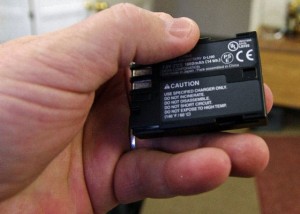Can a Lithium-Ion Battery Fire Be Put Out with a Conventional Fire Extinguisher?
Lithium-ion battery installations need to be well-engineered, with redundant safety systems and automatic disconnects.
December 5, 2014
Question: At a recent boat show I had the opportunity to lift the cover off of a lithium-ion battery installation on a new boat to see how it was all arranged.

In the event of a thermal runaway, that standard fire extinguisher wouldn't do much good.
Notice the standard engine room fire extinguisher in the upper part of the photo [red canister]. I’ve been under the impression that there is no conventional fire extinguisher that can extinguish a lithium battery fire in a thermal runaway situation. The sales person present wasn’t too helpful. This just seems wrong to me. What’s your take?
Answer: This is not the first time I’ve seen this mistake. You are quite correct in your assessment that the extinguisher really wouldn’t do anything if the cause of the fire was a li-ion thermal runaway. In that kind of fire situation the batteries would probably burn their way through the bottom of the boat and then it would sink to the bottom of the ocean! A big problem.
Based on the color of the battery cases I believe we are looking at Victron Energy battery packs. Victron uses lithium-ion phosphate (LiFePO4) electrolyte, which has pretty much established itself as the “safe” option in this technology area. As long as these batteries are also connected to the matched BMS (battery management system) that Victron provides, there should be litttle cause for worry. The caveat is that it must be part of a properly engineered system. Victron certainly offers such a system, with redundancy built in, and if things should go wrong on the boat the batteries will automatically get disconnected from the boat’s system. If the boat were to burn for some reason other than thermal runaway, the components in the batteries are essentially non-flammable, so they won’t contribute to the fire. You’d have a bigger worry with any gasoline or diesel fuel stored on board.
The idea here is fire prevention by mitigating the possibility of creating a thermal runaway situation in one or all of the cells of the batteries. Done properly, we’re there at this point.












